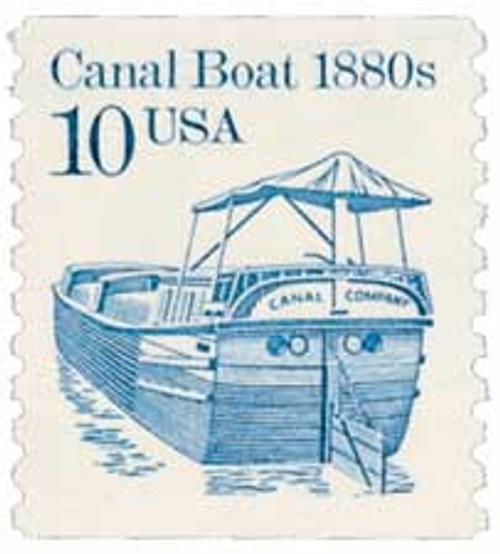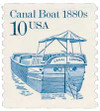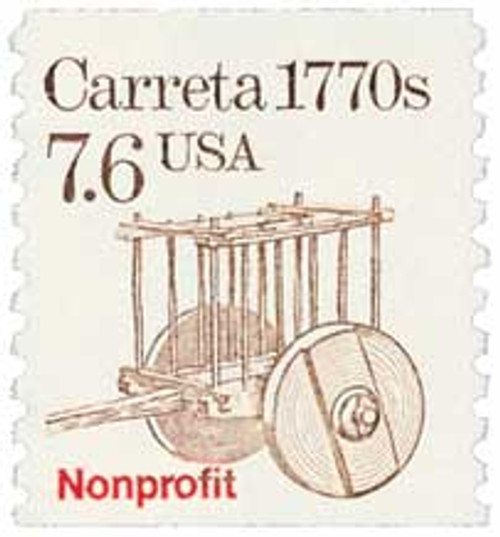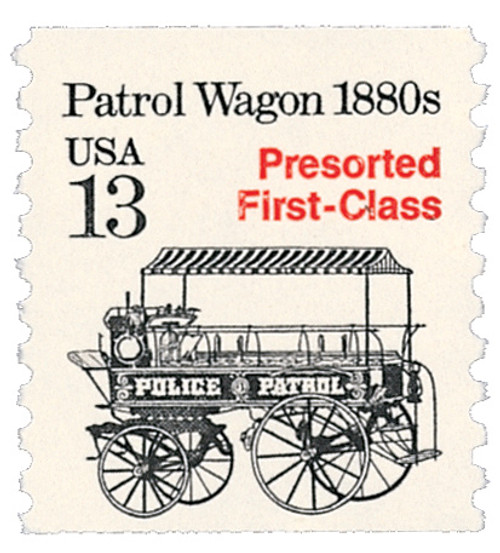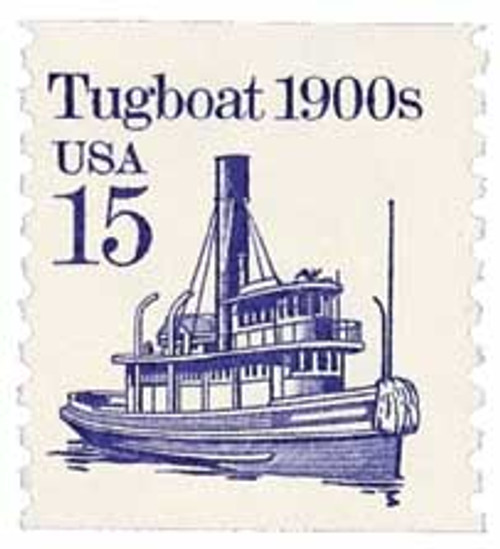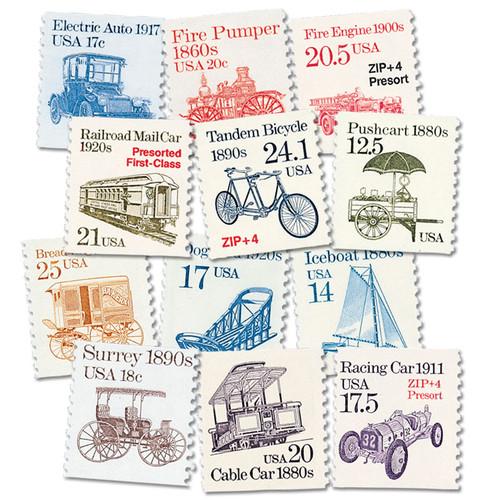
# 2257 - 1987 10c Transportation Series: Canal Boat, 1880s
U.S. #2257
1987 10¢ Canal Boat, 1880s
Transportation Series
- First Transportation Series stamp to picture watercraft
- Unofficially honors the Erie Canal
Stamp Category: Definitive
Series: Transportation
Value: 10¢, paid the surcharge on oversized first-class mail and third-class mail weighing one ounce or less
First Day of Issue: April 11, 1987
First Day City: Buffalo, New York
Quantity Issued: 32,808,000
Printed by: Bureau of Engraving and Printing
Printing Method: Engraved
Format: Coils of 100 and 3,000
Perforations: 10 vertical
Color: Blue
Why the stamp was issued: This stamp didn’t replace any existing 10¢ stamp and was issued to pay the surcharge on oversized first-class mail and third-class mail weighing one ounce or less. While the design doesn’t state it, the stamp seemingly honors the Erie Canal in addition to canal boats. The USPS literature on the stamp discussed the Erie Canal and the first day ceremony was held in a city closely tied to the Erie Canal.
About the stamp design: This was William H. Bond’s fifth stamp in the Transportation Series. The boat pictured sits low to the water and is wide with a rounded bow and stern.
First Day City: The First Day ceremony for this stamp was held at the ALPEX stamp show held by the Plewacki American Legion Post Stamp Society at the Marine Midland Bank auditorium in Buffalo, New York, the western terminus of the Erie Canal.
Unusual fact about this stamp: Varieties in tagging, including tagging omitted, as well as imperforate errors, exist.
About the Transportation Series: On May 18, 1981, the USPS issued the first stamp in the Transportation Series, US #1907, picturing the Surrey, a doorless four-wheeled carriage. For the first time in US history, a coil stamp featured its own unique design rather than simply copying that of the current definitive stamp. Over 50 more coil stamps would be issued over the course of the next 15 years, each picturing a different mode of transportation. All of these types of transportation were used since American independence.
The various denominations provided face values to exactly match the rates for several categories of Third-Class mail (bulk rate and quantity-discounted mail). As the rates changed, new stamps with new values were added. Never before had a stamp series included so many fractional cent values.
The Bureau of Engraving and Printing printed most of the stamps in the Transportation Series, although private contractors printed a few. All but a few of the later stamps were produced by engraved intaglio. Differences in precancels, tagging, paper and gum provide a large number of varieties.
Scott Catalog separates the Transportation stamps into four groups. The stamps in the first group (#1897-1908) generally have the denomination in small type with a “c” next to it. These stamps were printed on the Cottrell rotary press, which joined together two plates to make a sleeve. The gaps between these plates created depressions where ink would collect and create joint lines on the stamps. Later issues were printed on a different press and didn’t have these joint lines.
The second group (#2123-36) had larger numbers with no “c.” The third group (#2252-66) was similar in appearance to the second group, but service inscriptions were added to the designs. These stamps also used a variety of paper and gum as well as different types of tagging. The fourth group (#2451-68) marked the end of fractional values. Now bulk mailers would use either the 5¢ or 10¢ stamp and then pay the difference from the actual postage rate.
The last stamp in the Transportation Series, the 20¢ Cog Railway, was issued on June 9, 1995, at the TEXPEX ’95 stamp show in Dallas, Texas. This marked the end of the largest US definitive series up to that time. Three new series would eventually replace it – American Transportation, American Culture, and American Scenes. Additionally, the Great Americans would go on to become the largest American definitive series.
History the stamp represents: On October 26, 1825, the Erie Canal opened, offering a quicker shipping route through New York’s waterways.
In the early 1800s, sending goods west from New York City across the state was expensive and took a lot of time. There were no railroads yet and it took two weeks to travel by stagecoach. Several New York legislators proposed the idea of building a canal across the state, and they received tremendous support from Governor DeWitt Clinton.
Clinton had served as a delegate to the New York State Constitutional Convention, a US senator, and mayor of New York City before being elected governor in 1817. While in office, he pushed for the construction of the Erie Canal to connect the upper Hudson River to the eastern shore of Lake Erie.
Clinton convinced the legislature to supply $7 million for this project. His opponents thought the canal was impractical and named it “Clinton’s Ditch.” Clinton’s proposed canal would be 363 miles long, 40 feet wide, and four feet deep. Construction on the canal began on July 4, 1817, in Rome, New York (just 18 miles from Mystic’s home in Camden, New York). The first 15-mile section (stretching from Rome to Utica) opened in 1819.
After more than two years of digging, the Erie Canal officially opened on October 26, 1825. Clinton, who had planned the canal’s design and supervised its construction, played a major role in the opening ceremonies. That day he boarded the Seneca Chief in Buffalo and traveled the full length of the canal, then the Hudson, all the way to New York City.
As part of the ceremony, cannons were set up along the entire length of the river, within hearing distance of each other. As Clinton left Buffalo, the first cannon was shot off, which signaled the next one to fire. Cannons boomed the message all the way to New York City within 90 minutes, the fastest communication of the time.
Clinton arrived in New York City on November 4. Upon arrival in New York Harbor, he emptied two small barrels of water from Lake Erie into the harbor to signify the joining of the two bodies of water.
The Erie Canal was successful from the start. It was much faster to transport goods up the Hudson River and through the 83 locks of the canal than to travel by land, and it cost about 95% less. The canal opened the West to settlement and trade and gave Midwest farmers an economical way to get their grain to market. New York City became the largest port city in the United States, and the population of New York State increased dramatically along the canal route.
The critics of DeWitt Clinton were silenced when the importance of the canal to the country was realized. Some consider Clinton an unsung American hero.
U.S. #2257
1987 10¢ Canal Boat, 1880s
Transportation Series
- First Transportation Series stamp to picture watercraft
- Unofficially honors the Erie Canal
Stamp Category: Definitive
Series: Transportation
Value: 10¢, paid the surcharge on oversized first-class mail and third-class mail weighing one ounce or less
First Day of Issue: April 11, 1987
First Day City: Buffalo, New York
Quantity Issued: 32,808,000
Printed by: Bureau of Engraving and Printing
Printing Method: Engraved
Format: Coils of 100 and 3,000
Perforations: 10 vertical
Color: Blue
Why the stamp was issued: This stamp didn’t replace any existing 10¢ stamp and was issued to pay the surcharge on oversized first-class mail and third-class mail weighing one ounce or less. While the design doesn’t state it, the stamp seemingly honors the Erie Canal in addition to canal boats. The USPS literature on the stamp discussed the Erie Canal and the first day ceremony was held in a city closely tied to the Erie Canal.
About the stamp design: This was William H. Bond’s fifth stamp in the Transportation Series. The boat pictured sits low to the water and is wide with a rounded bow and stern.
First Day City: The First Day ceremony for this stamp was held at the ALPEX stamp show held by the Plewacki American Legion Post Stamp Society at the Marine Midland Bank auditorium in Buffalo, New York, the western terminus of the Erie Canal.
Unusual fact about this stamp: Varieties in tagging, including tagging omitted, as well as imperforate errors, exist.
About the Transportation Series: On May 18, 1981, the USPS issued the first stamp in the Transportation Series, US #1907, picturing the Surrey, a doorless four-wheeled carriage. For the first time in US history, a coil stamp featured its own unique design rather than simply copying that of the current definitive stamp. Over 50 more coil stamps would be issued over the course of the next 15 years, each picturing a different mode of transportation. All of these types of transportation were used since American independence.
The various denominations provided face values to exactly match the rates for several categories of Third-Class mail (bulk rate and quantity-discounted mail). As the rates changed, new stamps with new values were added. Never before had a stamp series included so many fractional cent values.
The Bureau of Engraving and Printing printed most of the stamps in the Transportation Series, although private contractors printed a few. All but a few of the later stamps were produced by engraved intaglio. Differences in precancels, tagging, paper and gum provide a large number of varieties.
Scott Catalog separates the Transportation stamps into four groups. The stamps in the first group (#1897-1908) generally have the denomination in small type with a “c” next to it. These stamps were printed on the Cottrell rotary press, which joined together two plates to make a sleeve. The gaps between these plates created depressions where ink would collect and create joint lines on the stamps. Later issues were printed on a different press and didn’t have these joint lines.
The second group (#2123-36) had larger numbers with no “c.” The third group (#2252-66) was similar in appearance to the second group, but service inscriptions were added to the designs. These stamps also used a variety of paper and gum as well as different types of tagging. The fourth group (#2451-68) marked the end of fractional values. Now bulk mailers would use either the 5¢ or 10¢ stamp and then pay the difference from the actual postage rate.
The last stamp in the Transportation Series, the 20¢ Cog Railway, was issued on June 9, 1995, at the TEXPEX ’95 stamp show in Dallas, Texas. This marked the end of the largest US definitive series up to that time. Three new series would eventually replace it – American Transportation, American Culture, and American Scenes. Additionally, the Great Americans would go on to become the largest American definitive series.
History the stamp represents: On October 26, 1825, the Erie Canal opened, offering a quicker shipping route through New York’s waterways.
In the early 1800s, sending goods west from New York City across the state was expensive and took a lot of time. There were no railroads yet and it took two weeks to travel by stagecoach. Several New York legislators proposed the idea of building a canal across the state, and they received tremendous support from Governor DeWitt Clinton.
Clinton had served as a delegate to the New York State Constitutional Convention, a US senator, and mayor of New York City before being elected governor in 1817. While in office, he pushed for the construction of the Erie Canal to connect the upper Hudson River to the eastern shore of Lake Erie.
Clinton convinced the legislature to supply $7 million for this project. His opponents thought the canal was impractical and named it “Clinton’s Ditch.” Clinton’s proposed canal would be 363 miles long, 40 feet wide, and four feet deep. Construction on the canal began on July 4, 1817, in Rome, New York (just 18 miles from Mystic’s home in Camden, New York). The first 15-mile section (stretching from Rome to Utica) opened in 1819.
After more than two years of digging, the Erie Canal officially opened on October 26, 1825. Clinton, who had planned the canal’s design and supervised its construction, played a major role in the opening ceremonies. That day he boarded the Seneca Chief in Buffalo and traveled the full length of the canal, then the Hudson, all the way to New York City.
As part of the ceremony, cannons were set up along the entire length of the river, within hearing distance of each other. As Clinton left Buffalo, the first cannon was shot off, which signaled the next one to fire. Cannons boomed the message all the way to New York City within 90 minutes, the fastest communication of the time.
Clinton arrived in New York City on November 4. Upon arrival in New York Harbor, he emptied two small barrels of water from Lake Erie into the harbor to signify the joining of the two bodies of water.
The Erie Canal was successful from the start. It was much faster to transport goods up the Hudson River and through the 83 locks of the canal than to travel by land, and it cost about 95% less. The canal opened the West to settlement and trade and gave Midwest farmers an economical way to get their grain to market. New York City became the largest port city in the United States, and the population of New York State increased dramatically along the canal route.
The critics of DeWitt Clinton were silenced when the importance of the canal to the country was realized. Some consider Clinton an unsung American hero.

